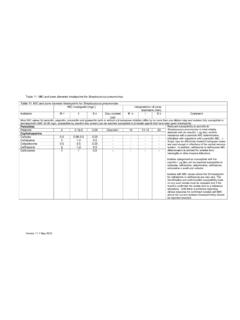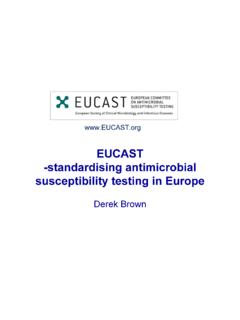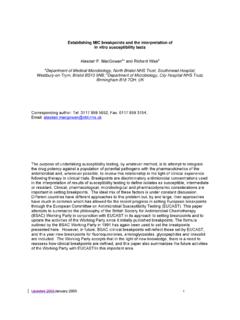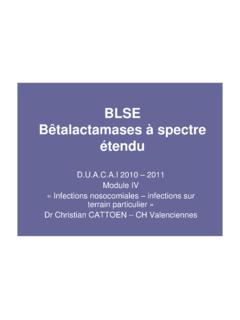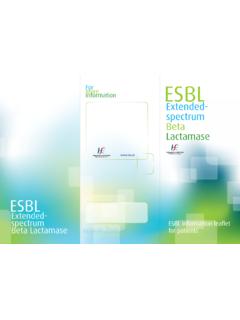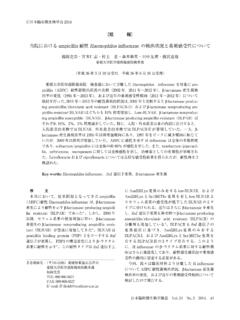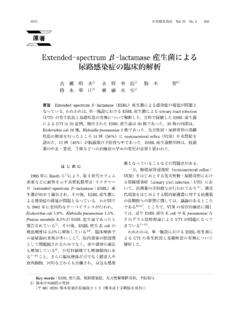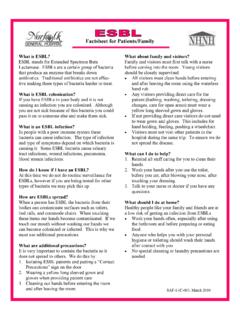Transcription of Detection of β-lactamase-mediated resistance - BSAC
1 Detection of -lactamase-mediated resistance David M. Livermorea* and Derek F. J. Brownb aAntibiotic resistance Monitoring and Reference Laboratory, Central Public Health Laboratory, 61 Colindale Avenue, London, NW9 5HT; bClinical Microbiology and Public Health Laboratory, Addenbrooke s Hospital, Hills Road, Cambridge, CB2 2QW, UK Tel: +44-20-8200-4400; Fax: +44-20-8200-3292; Email: -Lactams are the most widely used antibiotics, and - lactamases are the greatest source of resistance to them. Colorimetric tests are good, rapid, indicators of -lactamase production and its contingent resistance in Haemophilus, Moraxella and Neisseria spp.
2 They can also be applied to Gram-negative bacilli but are less useful, since the usual question is not whether a -lactamase is produced but which -lactamase? Accurate identification of the - lactamases of Enterobacteriaceae demands gene or protein sequencing, but the broad type of enzyme can often be inferred from antibiotic susceptibility profile. resistance to indicator third generation cephalosporins implies extended-spectrum -lactamase (ESBL) production in Escherichia coli and Klebsielia spp., especially if susceptibility to cefoxitin is retained. With the emergence of CTX-M ESBLs, it is necessary to use cefotaxime as well as ceftazidime as an indicator, or to use cefpodoxime.
3 ESBL production can be confirmed with double disc synergy tests or with various commercial kits. Derepression of AmpC - lactamases in Enterobacter spp. and Citrobacter freundii is also important and can be inferred from cross- resistance encompassing -lactamase inhibitor combinations as well as all cephalosporins except fourth-generation agents. Antagonism between cefoxitin and cefotaxime implies the presence of inducible AmpC enzymes in Enterobacter spp., indicating the risk of segregation of derepressed mutants. In general, though, this risk is better predicted from accurate species identification. Metallo-carbapenemases are slowly emerging and present a new Detection challenge, firstly because carbapenem resistance does not always accompany enzyme production and secondly because EDTA, which is used as an inhibitor in some diagnostic tests, may also exert other effects on the cell.
4 August 2005 1 Introduction - lactamases are the main cause of bacterial resistance to penicillins and cephalosporins. Definitive identification of these enzyme is only possible by gene or protein sequencing;1 aspects beyond the scope of diagnostic laboratories or of this review. Nevertheless, simple -lactamase Detection and typing tests can be valuable in the clinical laboratory. These include: (i) direct tests for -lactamase activity in fastidious Gram-negative species; (ii) tests for extended -Iactamases (ESBLs); and (iii) tests for inducibility of chromosomal - lactamases . Tests for metallo-carbapenemases are being developed and may become increasingly useful if these enzymes spread in the future.
5 In the longer term, gene chip technology may allow precise routine identification of Tests for Detection of - lactamases Direct tests for -lactamase activity Direct -lactamase tests are mostly used for Haemophilus influenzae, Moraxella catarrhalis and Neisseria spp., where few different enzyme types occur, and where enzyme production has clear implications for therapy. Direct tests can be applied to other species, but are less useful, since the important question usually is not whether a -lactamase is produced but which -lactamase. Numerous -lactamase Detection tests have been devised1 but few are convenient for routine use. Most use chromogenic cephalosporins, or link the hydrolysis of penicillin to a colour change mediated by iodine or a pH indicator.
6 Chromogenic cephalosporins are very specific, whereas acidification and the reduction of iodine can occur for reasons other than -lactamase action, potentially giving false-positive results. Positive and negative controls should be run in parallel with all tests but, because of the risk of false-positive results, are especially critical for the acidimetric and iodometric methods. Nitrocefin test. Nitrocefin is a chromogenic cephalosporin that changes from yellow to red on hydrolysis. It provides the most sensitive test for most - lactamases , exceptions being staphylococcal penicillinase and ROB-1, an uncommon plasmid-mediated enzyme of Nitrocefin is available as pure powder from Becton Dickinson (Oxford, UK).
7 Powder can also be obtained in commercial preparations, ( Oxoid, Basingstoke, UK), where it is supplied together with a vial of diluent and is mixed with materials that facilitate solubilization. Various commercial devices based on nitrocefin are also available ( from Oxoid and Becton Dickinson). The method described below is for pure powder; users of other preparations and devices should follow the instructions provided with them. Another chromogenic cephalosporin, PADAC,4 exists but is less sensitive and is not readily available. A mM nitrocefin solution is prepared by dissolving mg of powder in mL of dimethylsulphoxide (DMSO) then diluting with mL of M phosphate buffer, pH This solution is stable for 10 days at 4 C in a foil-wrapped bottle.
8 Glass containers should be used, since DMSO degrades plastics. Colonies of the test isolates are scraped from nutrient agar plates and are suspended in 20 L volumes of M phosphate buffer pH , to produce a dense suspension on a glass slide, and 20 L amounts of the nitrocefin solution are added. -Lactamase activity is indicated by a red colour within 1-2 min. Weak activities may take longer to appear, but reactions taking >10 min should be treated with scepticism, as they may reflect the secondary -lactamase activity of those penicillin-binding proteins that form unstable acyl complexes. Iodometric tests. Hydrolysis of penicillin yields penicilloic acid, which reduces iodine, decolourising starch-iodine complex.
9 This reaction can be exploited to detect -lactamase activity in tubes or on paper strips. These tests are particularly sensitive for staphylococcal penicillinase, but are less sensitive than nitrocefin for most of the - lactamases from Gram-negative bacteria. (i) Tube method. Benzylpenicillin, 6 g/L in M phosphate buffer pH , is distributed in mL quantities in tubes or a microtitre Bacterial growth from agar (not broth) is suspended in these solutions until they are heavily turbid (c. 109 cfu/mL). The suspensions are held at room temperature for 30-60 min, then 20 L volumes of 1% (w/v) soluble starch in distilled water are added, followed by 20 L of 2% (w/v) iodine in 53% (w/v) aqueous potassium iodide.
10 -lactamase activity is indicated by decolourisation of the iodine August 2005 2 within 5 min. Positive and negative controls are vital, as extraneous protein reduces iodine, and over-heavily inoculated tests may give false-positive results. (ii) Paper strip method. To prepare iodometric paper strips, g of soluble starch is added to 100 mL of distilled water and dissolved by After cooling, 1 g of benzylpenicillin is added. Filter papers (1 x 5 cm, Whatman No. 3; Whatman, Maidstone, UK, or similar) are soaked in this solution, then air-dried for 2 h. The strips, which are stable for 1 year at 20 C, are moistened with 2% (w/v) iodine in 53% (w/v) aqueous potassium iodide before use.


